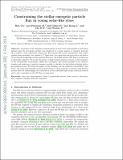Files in this item
Constraining the stellar energetic particle flux in young solar-like stars
Item metadata
| dc.contributor.author | Rab, Ch | |
| dc.contributor.author | Padovani, M. | |
| dc.contributor.author | Güdel, M. | |
| dc.contributor.author | Kamp, I. | |
| dc.contributor.author | Thi, W. -F. | |
| dc.contributor.author | Woitke, P. | |
| dc.contributor.editor | Elmegreen, Bruce G. | |
| dc.contributor.editor | Tóth, L. Viktor | |
| dc.contributor.editor | Güdel, Manuel | |
| dc.date.accessioned | 2020-07-12T23:35:48Z | |
| dc.date.available | 2020-07-12T23:35:48Z | |
| dc.date.issued | 2020-01-13 | |
| dc.identifier | 258237548 | |
| dc.identifier | 3d4a2d0a-0b46-45e7-91ee-9f72327642ba | |
| dc.identifier | 85078013440 | |
| dc.identifier.citation | Rab , C , Padovani , M , Güdel , M , Kamp , I , Thi , W -F & Woitke , P 2020 , Constraining the stellar energetic particle flux in young solar-like stars . in B G Elmegreen , L V Tóth & M Güdel (eds) , Origins : From the Protosun to the First Steps of Life . Proceedings of the International Astronomical Union , no. S345 , vol. 14 , International Astronomical Union (IAU) , pp. 310-311 , IAU Symposium 345 , Vienna , Austria , 20/08/18 . https://doi.org/10.1017/S174392131900156X | en |
| dc.identifier.citation | conference | en |
| dc.identifier.issn | 1743-9213 | |
| dc.identifier.other | ArXiv: http://arxiv.org/abs/1902.00914v1 | |
| dc.identifier.uri | https://hdl.handle.net/10023/20235 | |
| dc.description.abstract | Anomalies in the abundance measurements of short lived radionuclides in meteorites indicate that the protosolar nebulae was irradiated by a large number of energetic particles (E >∼10 MeV), often called solar cosmic rays. The particle flux of the contemporary Sun cannot explain these anomalies, but, similar to T Tauri stars, the young Sun was more active and probably produced enough high energy particles. However, the stellar particle (SP) flux of young stars is essentially unknown. We model the impact of high-energy ionization sources on the chemistry of the circumstellar environment (disks and envelopes). The model includes X-ray radiative transfer and makes use of particle transport models to calculate the individual molecular hydrogen ionization rates. We study the impact on the chemistry via the ionization tracers HCO+ and N2H+. We argue that spatially resolved observations of those molecules combined with detailed models allow for disentangling the contribution of the individual high-energy ionization sources and to put constraints on the SP flux in young stars. | |
| dc.format.extent | 98777 | |
| dc.language.iso | eng | |
| dc.publisher | International Astronomical Union (IAU) | |
| dc.relation.ispartof | Origins | en |
| dc.relation.ispartofseries | Proceedings of the International Astronomical Union | en |
| dc.subject | Stars: pre-main-sequence | en |
| dc.subject | (Stars:) circumstellar matter | en |
| dc.subject | Stars: activity | en |
| dc.subject | Astrochemistry | en |
| dc.subject | Radiative transfer | en |
| dc.subject | Methods: numerical | en |
| dc.subject | QB Astronomy | en |
| dc.subject | QC Physics | en |
| dc.subject | QD Chemistry | en |
| dc.subject | NDAS | en |
| dc.subject.lcc | QB | en |
| dc.subject.lcc | QC | en |
| dc.subject.lcc | QD | en |
| dc.title | Constraining the stellar energetic particle flux in young solar-like stars | en |
| dc.type | Conference item | en |
| dc.contributor.institution | University of St Andrews. School of Physics and Astronomy | en |
| dc.contributor.institution | University of St Andrews. St Andrews Centre for Exoplanet Science | en |
| dc.identifier.doi | 10.1017/S174392131900156X | |
| dc.date.embargoedUntil | 2020-07-13 |
This item appears in the following Collection(s)
Items in the St Andrews Research Repository are protected by copyright, with all rights reserved, unless otherwise indicated.

